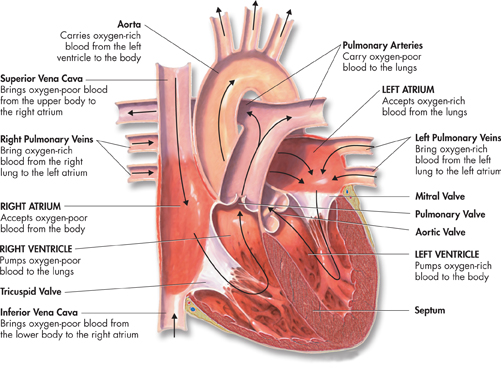The Heart
 How does the heart pump blood through the body?
How does the heart pump blood through the body?
Much of the time, you're probably not even aware of your heart at work. But when you exercise, you can feel your heart beating near the center of your chest.
Heart Structure Your heart, which is a hollow organ about the size of a clenched fist, is composed almost entirely of muscle. The muscles begin contracting before you are born and stop only when you die. In the walls of the heart, two thin layers of epithelial and connective tissue form a sandwich around a muscle layer called the myocardium.  Powerful contractions of the myocardium pump blood through the circulatory system. An adult's heart contracts on average 72 times a minute, pumping about 70 milliliters of blood with each contraction.
Powerful contractions of the myocardium pump blood through the circulatory system. An adult's heart contracts on average 72 times a minute, pumping about 70 milliliters of blood with each contraction.
As Figure 33–2 shows, the heart is divided into four chambers. A wall called the septum separates the right side of the heart from the left side. The septum prevents oxygen-poor and oxygen-rich blood from mixing. On each side of the septum are an upper and lower chamber. Each upper chamber, or atrium (plural: atria), receives blood from the body. Each lower chamber, or ventricle, pumps blood out of the heart.
 In Your Notebook An Olympic pool contains about 2,000,000 liters of water. In one year, could an average heart pump enough blood to fill an Olympic pool? Explain your answer.
In Your Notebook An Olympic pool contains about 2,000,000 liters of water. In one year, could an average heart pump enough blood to fill an Olympic pool? Explain your answer.
BUILD Vocabulary
WORD ORIGINS The word cardiac, the prefix cardio-, and the suffix -cardium are all based on the Greek word kardia, which means “heart.”

FIGURE 33–2 The Heart The human heart has four chambers: the right atrium, the right ventricle, the left atrium, and the left ventricle. Valves located between the atria and ventricles and between the ventricles and vessels leaving the heart prevent blood from flowing backward between heartbeats.
dTable of Contents
- Formulas and Equations
- Applying Formulas and Equations
- Mean, Median, and Mode
- Estimation
- Using Measurements in Calculations
- Effects of Measurement Errors
- Accuracy
- Precision
- Comparing Accuracy and Precision
- Significant Figures
- Calculating With Significant Figures
- Scientific Notation
- Calculating With Scientific Notation
- Dimensional Analysis
- Applying Dimensional Analysis




